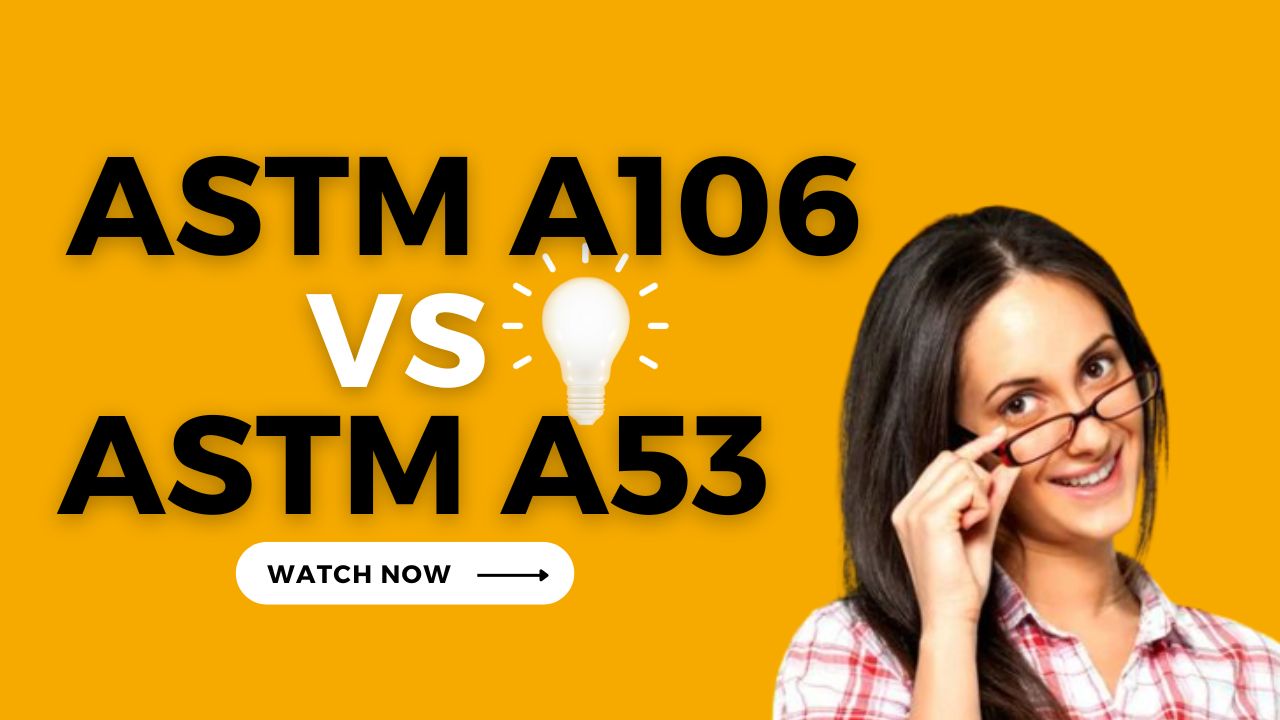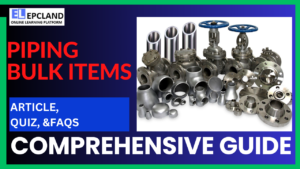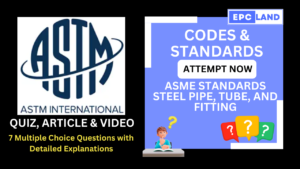Introduction
When it comes to selecting the right materials for industrial applications, understanding the nuances of different standards is crucial. ASTM A106 and ASTM A53 are two commonly used specifications in the realm of steel pipes. While they might seem similar at first glance, these standards have unique properties that make them suitable for specific applications. In this article, we’ll delve into the differences between ASTM A106 and ASTM A53, shedding light on their uses, characteristics, and key distinctions.
Table of Contents
Do not miss the detailed course 7 Modules of Piping Codes & Standards
Enrollment link
Check out the Similar Articles on ASTM Standards
Introduction
Steel pipes are essential components in various industries, serving as conduits for liquids and gases. Two commonly used standards for steel pipes are ASTM A106 and ASTM A53, each designed for specific applications. Understanding the differences between these standards is crucial for selecting the right pipe for your project.
The Role of Steel Pipes
Steel pipes are vital for applications such as transporting oil, gas, steam, and water in industries like construction, manufacturing, and energy production.
ASTM Standards for Steel Pipes
ASTM standards ensure the quality, consistency, and performance of steel pipes in various applications, providing a basis for reliability and safety.
ASTM A106: Seamless Carbon Steel Pipe for High-Temperature Service
ASTM A106 is a standard specification for seamless carbon steel pipes designed for high-temperature service.
ASTM A106 Grades
- Grade A: Suitable for general structural purposes and low-pressure applications.
- Grade B: Intended for high-temperature and high-pressure service, commonly used in power plants and refineries.
- Grade C: Similar to Grade B but with added requirements for enhanced weldability and ductility.
Chemical Composition of ASTM A106 Grades
| Element | Grade A | Grade B | Grade C |
|---|---|---|---|
| Carbon (C) | 0.25% max | 0.30% max | 0.35% max |
| Manganese (Mn) | 0.27-0.93% | 0.29-1.06% | 0.29-1.06% |
| Phosphorus (P) | 0.035% max | 0.035% max | 0.035% max |
| Sulfur (S) | 0.035% max | 0.035% max | 0.035% max |
Mechanical Properties of ASTM A106 Grades
| Property | Grade A | Grade B | Grade C |
|---|---|---|---|
| Tensile Strength | 48,000 psi (330 MPa) | 60,000 psi (415 MPa) | 70,000 psi (485 MPa) |
| Yield Strength | 30,000 psi (205 MPa) | 35,000 psi (240 MPa) | 40,000 psi (275 MPa) |
| Elongation | 35% min | 30% min | 30% min |
Do not miss the detailed course 7 Modules of Piping Codes & Standards
Enrollment link
ASTM A53: Welded and Seamless Steel Pipe
ASTM A53 is a standard specification for both welded and seamless steel pipes, suitable for various applications.
ASTM A53 Grades
- Type E: Electric-resistance-welded (ERW) pipes suitable for coiling, bending, flanging, and other forming operations.
- Type S: Seamless pipes, widely used in pressure systems and higher-temperature applications.
- Type F: Furnace-welded pipes with a continuous weld for general use.
Chemical Composition of ASTM A53 Grades
| Element | Type E | Type S | Type F |
|---|---|---|---|
| Carbon (C) | 0.30% max | 0.30% max | 0.30% max |
| Manganese (Mn) | 1.20% max | 1.20% max | 1.20% max |
| Phosphorus (P) | 0.050% max | 0.050% max | 0.050% max |
| Sulfur (S) | 0.045% max | 0.045% max | 0.045% max |
Mechanical Properties of ASTM A53 Grades
| Property | Type E | Type S | Type F |
|---|---|---|---|
| Tensile Strength | 48,000 psi (330 MPa) | 60,000 psi (415 MPa) | 58,000 psi (400 MPa) |
| Yield Strength | 30,000 psi (205 MPa) | 35,000 psi (240 MPa) | 36,000 psi (250 MPa) |
| Elongation | 28% min | 30% min | 23% min |
Differences Between ASTM A106 and ASTM A53
While both ASTM A106 and ASTM A53 cover steel pipes, they have distinct differences in terms of manufacturing, applications, and specific requirements.
Manufacturing Process
- ASTM A106: Specifies seamless carbon steel pipes, making them suitable for high-temperature service and industries like power plants and refineries.
- ASTM A53: Includes both seamless and welded pipes, providing versatility for various applications, including pressure systems and general use.
Application Focus
- ASTM A106: Primarily intended for high-temperature and high-pressure service, commonly used in applications where elevated temperatures are a concern.
- ASTM A53: Suitable for a wide range of applications, including pressure systems and general use where the focus is on cost-effective steel piping.
Quality Control & Testing
Both ASTM A106 and ASTM A53 require stringent quality control measures to ensure the pipes’ compliance with specifications. Key aspects of quality control include chemical analysis, mechanical testing, non-destructive testing (NDT), and visual inspection.
| Quality Control Measure | ASTM A106 | ASTM A53 |
|---|---|---|
| Chemical Analysis | Rigorous chemical analysis to verify the elemental composition. | Rigorous chemical analysis to verify the elemental composition. |
| Mechanical Testing | Mechanical testing, including tensile and yield strength tests. | Mechanical testing, including tensile and yield strength tests. |
| Non-Destructive Testing (NDT) | Non-destructive testing methods like ultrasonic testing (UT) and radiographic testing (RT). | Non-destructive testing methods like ultrasonic testing (UT) and radiographic testing (RT). |
| Visual Inspection | Visual inspection for surface imperfections, weld defects, and dimensional conformity. | Visual inspection for surface imperfections, weld defects, and dimensional conformity. |
Do not miss the detailed course 7 Modules of Piping Codes & Standards
Enrollment link
ASTM A106 vs ASTM A53: Exploring the Differences
ASTM A106: Seamless Carbon Steel Pipe
ASTM A106, often referred to as the “Standard Specification for Seamless Carbon Steel Pipe for High-Temperature Service,” is a widely used specification in various industries. This seamless pipe specification is designed for high-temperature applications, making it suitable for transporting fluids and gases at elevated temperatures. The seamless nature of ASTM A106 pipes ensures higher strength and allows for precise dimension control.
ASTM A53: Welded and Seamless Steel Pipe
On the other hand, ASTM A53, known as the “Standard Specification for Pipe, Steel, Black and Hot-Dipped, Zinc-Coated, Welded, and Seamless,” encompasses both welded and seamless pipes. While it covers a range of pipe types, it is commonly used for transporting non-critical fluids and gases. ASTM A53 pipes are available in various grades, including A, B, and C, each with different mechanical and chemical properties.
Application-Specific Considerations
ASTM A106 Applications: This specification finds its utility in industries requiring high-temperature resistance, such as power generation plants, refineries, and boilers. The seamless construction of A106 pipes ensures they can handle the stress and heat of such environments.
ASTM A53 Applications: ASTM A53 pipes, due to their versatility and cost-effectiveness, are commonly used in plumbing and construction projects. They are suitable for carrying fluids and gases in environments where high temperatures and pressures are not a primary concern.
Mechanical Properties and Grading
ASTM A106 Grading: ASTM A106 pipes are graded based on their mechanical properties, including tensile strength and yield strength. Grade A, Grade B, and Grade C pipes have varying levels of tensile strength, providing options for different applications.
ASTM A53 Grading: ASTM A53 pipes are categorized into three grades: A, B, and C. Grade A is designed for low-pressure applications, Grade B offers intermediate strength, and Grade C is intended for use in applications requiring higher mechanical strength.
Chemical Composition
Both ASTM A106 and ASTM A53 have specific chemical composition requirements to ensure the quality and performance of the pipes. These requirements include elements such as carbon, manganese, phosphorus, sulfur, and copper. The chemical composition affects the mechanical properties and corrosion resistance of the pipes.
Impact on Industries
Energy Sector: ASTM A106 pipes are essential in the energy sector, especially for conveying steam and high-temperature fluids. They play a vital role in power plants and refineries, contributing to efficient energy generation and distribution.
Construction Industry: ASTM A53 pipes are widely used in construction projects, including building infrastructure and plumbing systems. Their affordability and ease of installation make them a popular choice for a variety of applications.
Corrosion Resistance
Corrosion resistance is a critical consideration when selecting pipes for specific applications. Both ASTM A106 and ASTM A53 pipes can be galvanized to enhance their corrosion resistance. Galvanization involves coating the pipes with a layer of zinc, which acts as a protective barrier against corrosion, extending the pipes’ lifespan.
Environmental Impact
In terms of environmental impact, ASTM A106 pipes require higher energy consumption during manufacturing due to their seamless construction. In contrast, ASTM A53 pipes, which can be either welded or seamless, offer more flexibility in terms of manufacturing processes and energy usage.
Do not miss the detailed course 7 Modules of Piping Codes & Standards
Enrollment link
FAQs
Q: What is the main difference between ASTM A106 and ASTM A53?
Both ASTM A106 and ASTM A53 standards pertain to steel pipes, but the key distinction lies in their applications. ASTM A106 is geared towards high-temperature service, while ASTM A53 covers a broader range of applications, including plumbing and construction.
Q: Can ASTM A106 pipes be used for low-temperature applications?
While ASTM A106 is designed for high-temperature service, it can also be used for low-temperature applications if appropriate precautions are taken, such as impact testing and selecting the right grade.
Q: Are ASTM A53 pipes suitable for conveying high-temperature fluids?
ASTM A53 pipes are not recommended for conveying fluids at high temperatures. They are more suited for transporting non-critical fluids and gases in environments with lower temperature and pressure requirements.
Q: What are the galvanization options for ASTM A106 and ASTM A53 pipes?
Both ASTM A106 and ASTM A53 pipes can be galvanized to enhance their corrosion resistance. Galvanization involves coating the pipes with a layer of zinc, which acts as a protective barrier against corrosion.
Q: Can ASTM A53 Grade B pipes be used interchangeably with ASTM A106 Grade B pipes?
While both ASTM A53 Grade B and ASTM A106 Grade B pipes have similarities, they are not always interchangeable. It’s essential to consider the specific requirements of the application and consult relevant standards before making a decision.
Q: Which standard is more cost-effective for plumbing applications?
ASTM A53 pipes are generally considered more cost-effective for plumbing applications due to their versatility and wider range of uses. However, the choice between the two standards depends on factors like the required mechanical properties and the specific environment.
Conclusion
In the world of steel pipes, understanding the nuances between standards like ASTM A106 and ASTM A53 can make all the difference in the success of your projects. While both standards have their unique strengths and applications, their proper usage ensures the safety, efficiency, and longevity of the systems they are employed in. Whether you’re working in the energy sector, construction, or any other industry that relies on steel pipes, choosing the right standard is a crucial step toward achieving your project’s objectives.
Remember, the choice between ASTM A106 and ASTM A53 depends on factors such as the intended application, temperature, pressure requirements, and cost considerations. By weighing these factors carefully and consulting with experts, you can confidently select the best-suited standard for your needs.
Recommended courses (Published on EPCLand):
- Basics of Piping Engineering
- Piping Layout Engineering
- Piping Material Engineering
- Piping Stress Analysis
- Complete Course on Piping Engineering
- Material Requisitions
- Piping Material Specifications
- Valve Material Specifications
Related Video
Attempt Quiz
Question 1:
What is the primary difference between ASTM A106 and ASTM A53?
Explanation: The primary difference between ASTM A106 and ASTM A53 is that A106 is a specification for seamless carbon steel pipes, primarily used for high-temperature service, while A53 covers both seamless and welded carbon steel pipes, typically used for general applications.
Question 2:
Which of the two, ASTM A106 or ASTM A53, is suitable for high-temperature applications?
Explanation: ASTM A106 is suitable for high-temperature applications due to its seamless construction and higher strength, making it ideal for conveying fluids at elevated temperatures.
Question 3:
Which of the two, ASTM A106 or ASTM A53, is commonly used for low-temperature applications?
Explanation: While ASTM A53 can be used for low-temperature service, ASTM A106 is primarily intended for high-temperature applications. However, both standards have limitations on minimum temperature, and proper material selection is crucial.
Question 4:
Which ASTM standard allows for both seamless and welded carbon steel pipes?
Explanation: ASTM A53 covers both seamless and welded carbon steel pipes, offering more flexibility in terms of construction methods compared to ASTM A106, which is primarily for seamless pipes.
Question 5:
Which of the two, ASTM A106 or ASTM A53, is more commonly used for pressure piping and mechanical applications?
Explanation: ASTM A53 is more commonly used for pressure piping and mechanical applications due to its versatility, availability in both seamless and welded forms, and suitability for general-purpose applications.



